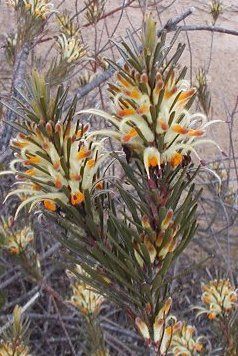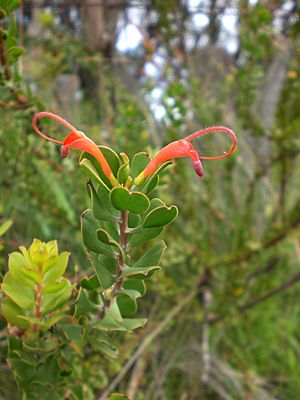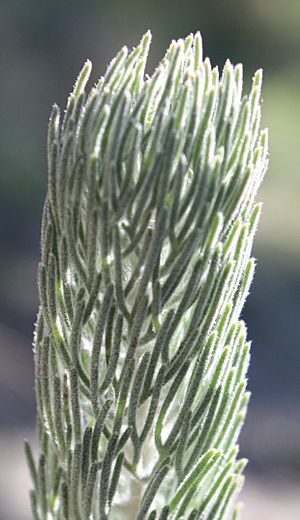Nelson's taxonomic arrangement of Adenanthos facts for kids

Ernest Charles Nelson's way of organizing Adenanthos plants was the first modern system for this group of plants. It was first shared in his 1978 article in the journal Brunonia. This new system replaced an older one made by George Bentham, which had been used for over a hundred years. Nelson later updated his system in 1995 for the Flora of Australia book series.
Contents
About Adenanthos Plants
Adenanthos is a group of about 30 different species of plants. They belong to the plant family called Proteaceae. These plants only grow in southern Australia. They are evergreen (meaning they stay green all year) and are usually shrubs (bushes).
Their flowers grow one by one and are pollinated by birds. If a flower is fertilised, it grows into a small, dry fruit called an achene. People don't usually grow these plants in gardens. Common names for these plants include woollybush, jugflower, and stick-in-the-jug.
How Adenanthos Was Discovered and Named
The first time a botanist (plant scientist) collected an Adenanthos plant was in September 1791. Archibald Menzies found it during the Vancouver Expedition at King George Sound in Western Australia. However, this discovery wasn't published right away.
The next year, Jacques Labillardière collected samples of A. cuneatus near Esperance Bay. In 1803, Jean Baptiste Leschenault de la Tour collected the same two species Menzies had found earlier. Labillardière officially named the group of plants Adenanthos in 1805. He published this in his book Novae Hollandiae Plantarum Specimen. The name Adenanthos comes from two Greek words: aden- (meaning "gland") and -anthos (meaning "flower"). This refers to the special "nectaries" (parts that produce nectar) on the flowers.
Bentham's Older System
By 1870, scientists had named 13 different Adenanthos species. That year, George Bentham published a 14th species. He also created the first system to organize the plants into smaller groups. He divided the genus into two main taxonomic sections: A. sect. Eurylaema and A. sect. Stenolaema.
Bentham based his groups on the shape of the flower tube (called the perianth tube).
- Plants in A. sect. Eurylaema have flower tubes that are curved and wider in the middle.
- Plants in A. sect. Stenolaema have flower tubes that are straight and not wide.
This system was used for over 100 years. But as more new species were found, Bentham's system became "very inadequate and incomplete." This meant it wasn't good enough anymore.
Nelson's Modern Arrangement
Ernest Charles Nelson's new way of organizing Adenanthos plants was first published in 1978. It appeared in his article "A taxonomic revision of the genus Adenanthos (Proteaceae)" in the journal Brunonia. In this work, Nelson named eight new species and four new subspecies (smaller groups within species). This brought the total number of species to 32.
Nelson kept Bentham's two main sections, Eurylaema and Stenolaema. However, he added more ways to tell them apart. Also, following modern rules for naming plants, A. sect. Stenolaema was renamed to A. sect. Adenanthos. Nelson then divided this section into two smaller groups called subsections: A. subsect. Anaclastos and A. subsect. Adenanthos. He gave detailed descriptions for each, but he suggested that the length of the flower tube was the easiest way to tell them apart.
Updates to Nelson's System
Nelson later changed his system in 1995 when he wrote about Adenanthos for the Flora of Australia book series. In this update, he removed the two subsections he had created earlier. He kept the two main sections, and by then, 40 species were listed. He also started using masculine names for the plants, following a new rule from 1994.
Here is Nelson's full arrangement of Adenanthos plants from 1995:


- Adenanthos
- A. sect. Eurylaema
- A. sect. Adenanthos
- A. drummondii
- A. dobagii
- A. apiculatus
- A. linearis
- A. pungens
- A. pungens subsp. pungens
- A. pungens subsp. effusus
- A. gracilipes
- A. venosus
- A. dobsonii
- A. glabrescens
- A. glabrescens subsp. glabrescens
- A. glabrescens subsp. exasperatus
- A. ellipticus
- A. cuneatus
- A. stictus
- A. ileticos
- A. forrestii
- A. eyrei
- A. cacomorphus
- A. flavidiflorus
- A. argyreus
- A. macropodianus
- A. terminalis
- A. sericeus
- A. sericeus subsp. sericeus
- A. sericeus subsp. sphalma
- A. × cunninghamii
- A. oreophilus
- A. cygnorum
- A. cygnorum subsp. cygnorum
- A. cygnorum subsp. chamaephyton
- A. meisneri
- A. velutinus
- A. filifolius
- A. labillardierei
- A. acanthophyllus
See also
 In Spanish: Arreglo taxonómico de Nelson sobre Adenanthos para niños
In Spanish: Arreglo taxonómico de Nelson sobre Adenanthos para niños

